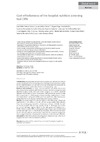Please use this identifier to cite or link to this item:
http://hdl.handle.net/10553/71255
| Title: | Cost-effectiveness of the hospital nutrition screening tool CIPA | Authors: | Suárez-Llanos, José Pablo Vallejo Torres, Laura García-Bello, Miguel Ángel Hernández-Carballo, Carolina Calderón-Ledezma, Eduardo Mauricio Rosat-Rodrigo, Adriá Delgado-Brito, Irina Pereyra-García-Castro, Francisca Benitez-Brito, Nestor Felipe-Pérez, Nieves Ramallo-Fariña, Yolanda Romero-Pérez, Juan Carlos |
UNESCO Clasification: | 32 Ciencias médicas | Keywords: | Cost-Benefit Analysis Inpatients Malnutrition Nutrition Assessment Quality Of Life |
Issue Date: | 2020 | Journal: | Archives Of Medical Science | Abstract: | Introduction: Hospital malnutrition is very common and worsens the clinical course of patients while increasing costs. Lacking clinical-economic studies on the implementation of nutrition screening encouraged the evaluation of the CIPA (Control of Food Intake, Protein, Anthropometry) tool. Material and methods: An open, non-randomized, controlled clinical trial was conducted on patients admitted to internal medicine and general and digestive surgery wards, who were either assigned to a control (standard hospital clinical care) or to an intervention, CIPA-performing ward (412 and 411, respectively; n = 823). Length of stay, mortality, readmission, in-hospital complications, and quality of life were evaluated. Cost-effectiveness was analysed in terms of cost per quality-adjusted life years (QALYs). Results: The mean length of stay was higher in the CIPA group, though not significantly (+ 0.95 days; p = 0.230). On the surgical ward, more patients from the control group moved to critical care units (p = 0.014); the other clinical variables did not vary. Quality of life at discharge was similar (p = 0.53), although slightly higher in the CIPA group at 3 months (p = 0.089). Patients under CIPA screening had a higher mean cost of € 691.6 and a mean QALY gain over a 3-month period of 0.0042. While the cost per QALY for the internal medicine patients was € 642 282, the results for surgical patients suggest that the screening tool is both less costly and more effective. Conclusions: The CIPA nutrition screening tool is likely to be cost-effective in surgical but not in internal medicine patients. | URI: | http://hdl.handle.net/10553/71255 | ISSN: | 1896-9151 | DOI: | 10.5114/aoms.2018.81128 | Source: | Archives Of Medical Science[ISSN 1734-1922],v. 16 (2), p. 273-281, (Febrero 2020) |
| Appears in Collections: | Artículos |
SCOPUSTM
Citations
4
checked on Apr 21, 2024
WEB OF SCIENCETM
Citations
4
checked on Feb 25, 2024
Page view(s)
152
checked on Jan 27, 2024
Download(s)
98
checked on Jan 27, 2024
Google ScholarTM
Check
Altmetric
Share
Export metadata
Items in accedaCRIS are protected by copyright, with all rights reserved, unless otherwise indicated.
